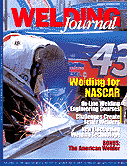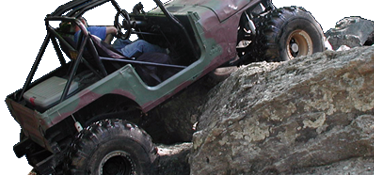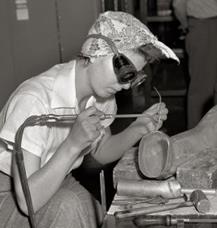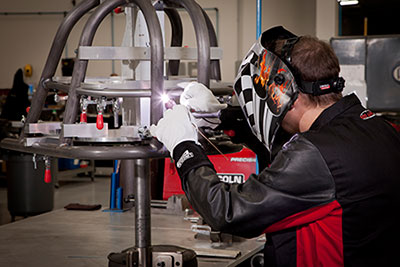Untitled Document link to better reading visual and source.
Video-Welding 4130 CrMoly
4130 was widely used in WWII airplanes! It was welded with oxyacetylene as TIG welding had just been invented! With oxyacetylene the material is being preheated and cooling is slow so the relatively high
carbon 4130 was considered very weldable. With TIG or MIG there is is usually no preheat used and cooling is very rapid leading to possible hard and brittle welds without employing precautions.
Of interest, in WWII about 40% of the workforce were women. This is a picture from War Archives is of Ann Rosner oxyacetylene welding an aircraft supercharger duct at Ford's Willow Run plant.
When writing
"Advanced Automotive Welding" for CarTech I talked with Gene Golliet about his welding of 4130 aircraft tubing in shops in Southern California during the War. Some experimental aircraft still use and prefer that welding process.
Welding 4130 Chrome Moly Steel for Race Cars

During the WW II era 4130 high strength steel was used for some aircraft components. At that time oxy-acetylene was the welding process of choice for many of these items. The preheat and slow cooling inherent with that process made welding the nominal 0.30 carbon steel relatively straight forward (assuming one could oxyacetylene weld!). However with more modern welding process like TIG and MIG, the cooling rates can be much faster and care must be taken to avoid forming high hardness and brittle Martensite on cooling transformation. On heavier sections preheat and post weld heat treatment should be used. With the proper post weld heat treatment strengths of 200,000 psi can be achieved with reasonable toughness by tempering the Martensite that forms in the heat treating process. However when welding race car tubing, preheat is not often used nor are the parts post weld heat treated.
Most of the tubing used for race car construction is referred to as normalized. This refers to the heat treatment and cooling rate the tubing was subjected to in manufacture. Most normalized tubing will range in tensile strength from 95,000 to 110,000 psi. This can be welded with the proper filler metals to achieve similar strengths. Although there are more weldable grades of steel (those with lower carbon content from 0.06 to 0.15) in the 100,000 to 115,000 psi tensile strength range readily available for plate and sheet, 4130 remains a commonly used grade for tubing. Just be sure to take the precautions noted when welding.
The following is extracted from an article I wrote for the American Welding Societies technical journal called "The Welding Journal". It has additional information to that presented in the publication. You can see the article in the 2003 April issue of the AWS Welding Journal:
PROPER FILLER METAL CHOICE FOR WELDING 4130

In the mid 1970’s, while managing an R&D group for a leading welding shielding gas/filler metals manufacturer, a phone call was received from a dragster chassis builder. They wanted to weld 4130 tubing and needed a filler metal suggestion. Being a “car buff,” a number of alternatives were considered to provide the optimum solution. After careful review of their requirements and desired welding practices, the solution was defined. They were welding 4130 normalized tubing, it would not be heat treated after welding, preheat was not desirable and most of the weld joints were intersecting tubes that required fillet welds. The best filler material to use was a low carbon alloy now called ESAB Spoolarc 65 (meeting an American Welding Society (AWS) ER70S-2 specification). The main objective is to produce porosity and crack free weld deposits. This welding alloy has a very low carbon content, nominally 0.06, which can handle dilution into the relatively high (in terms of weld metal), 0.30 carbon in the 4130. The resulting diluted weld deposit has a tensile strength of approximately 590 to 620 MPa ( 85,000 to 90,000 psi.) The actual strength will depend on the amount of dilution with the 4130, weld bead size and material thickness. This is usually an under match for the 4130 tubing which could have
a 760 to 800 MPa (100,000 to 115,000 psi) tensile strength depending on how the material was processed.
[Added Note: some normalized 4130 tubing may be only have a 90,000 psi tensile strength, it depends on the manufacturer] However, if extra joint strength is required, a slightly larger fillet size or gussets can be employed. In addition, this welding wire contains small amounts of aluminum, titanium and zirconium. Although these elements were initially added to handle welding over mill scale, they also contribute to a less fluid weld puddle. The benefit to the welder is, it is easier to make out of position welds. Note, it is suggested all welding on 4130 be performed on ground surfaces free of oil or grease (to keep the hydrogen levels as low as possible).
Several years after making this suggestion, when looking at a catalog from the dragster chassis manufacturer, it was interesting to note they were advertising their use of the ER70S-2 filler metal for their 4130 welding. In fact, they were offering it for sale for those customers purchasing frame parts and doing their own welding!
The Internet was searched to see what current recommendations were being made for joining 4130 tubing. Several hundred sites were found that recommend the ER70S-2 welding rod/wire alloy. It was the predominant recommendation. Typical of the Internet however, there were many improper descriptions of why this alloy should be used and several incorrect recommendations.
Need a higher strength deposit? If a higher strength weld is required for perhaps a butt weld that cannot be reinforced, strengthened with a gusset, or put in a less critically stressed area, there are possible solutions. The use of Spoolarc 83, which contains 0.50 Moly, will provide a weld deposit with higher strength. When diluted into the 4130 base material a weld tensile level of 760 to 800 MPa (110,000 to 115,000 psi) can be achieved. If this higher strength welding wire is employed, a minimum preheat of 65 degrees C (150 degrees F) is suggested. Weld strength can increase to a level slightly higher than the normalized 4130 with Spoolarc 83 (AWS ER 80D-2). Do not use an austenitic stainless steel such as an ER308L, (which is recommended on some Internet sites). Diluting this or similar austenitic stainless alloys with 4130 can lead to cracks. Also, consider that providing a higher strength weld deposit cannot compensate for the reduction in strength that will occur in the parent metal immediately next to the weld deposit.
For Parts to be "Heat Treated" (
meaning carefully raising the part to 1600 F; Quenching in water; then Reheating precisely to 1000 F; then Slow Cooling) After Welding: Note: modified with additional information obtained since writing this article.
Click to See Detailed Explanation:)
If the part is to be used for potentially high impact, structural applications and will be heat-treated after welding, a matching chemistry or matching hardenability filler metal to the 4130 should be employed. This may be a filler metal with somewhat lower carbon but increased moly, chrome, manganese etc. Because of the relatively high carbon, a minimum of 200 degrees C, (400 degrees F) preheat and very slow cooling after welding should be used to avoid cracking. Heat treating after welding refers to the finished welded part being heated to 870 degrees C (1600 degrees F), quenched in oil or water then tempered back to say 540 degrees C (1000 degrees F). A complex cycle, but this will result in a tensile strength of approximately 1035 MPa (150,000 psi). Since the weld is the same chemistry as the base material, it and the heat affected zone will have the similar properties as the base material when heat-treated. All critical welds of this type should be inspected for internal soundness to assure they are free from cracks.
End Of Abstracted Article
Advanced Automotive Welding that also discusses the implications in detail):
TIG, MIG, or Base
Rod, Wire or (Base)
Tensile Strength,
ksi
Elongation,
%
Impact Strength;
ft-lbs
TIG Weld ER70S-2 82 31% 170
MIG Weld ER70S-2 82 28% 45
MIG Weld ER80S-D2 110 22% 85
Base Material (Normalized 4130) ~90 ~25% ~60
Bottom Line:
Even when not diluted with 4130, ER70S-2 has a tensile strength just 9% under typical Normalized 4130. ER80S-D2 has a strength, with no dilution with the higher carbon 4130, that is 22% higher than Normalized 4130. Significantly higher strength weld metal than base metal may cause a weldment, when stressed under load, to yield excessively or initiate failures in the heat affected zone.
The elongation of Normalized 4130 (a measure of ductility) is less than the very ductile ER70S-2 weld. The higher strength ER80S-D2 weld has a lower elongation than the base material.
The impact properties of a TIG weld made with ER70S-2 are excellent at 170 ft-lbs. Note, the reason TIG welds have higher impact toughness than MIG welds made with the same alloy filler metal is discussed in the
Advanced Automotive Welding book.
CHECK WELD QUALITY
It is very important to check weld quality and understand the types of defects that could be encountered. Check your weld procedures and keep them consistent. You should make some sample welds and bend them to destruction to assure failure occurs only after considerable bending has taken place. Look for porosity or cracks that may have been present in the weld. It would be a wise investment to hire the services of an American Welding Society
(AWS) Certified Welding Inspector (CWI). There are some 25,000 registered. In fact many of them are members of the 65,000 member AWS. They can advise on procedures and what to check for such as small undercuts at the weld toe of fillet welds that can lead to premature failure.
Consistently following the proper weld procedures and knowing how to check for possible weld problems is of major importance.
Closing Suggestion
When welding 4130 chrome moly in the normalized condition, AWS ER70S-2 filler metal, with its low carbon content is the proper choice. Make sufficiently large fillets and make them flat, not concave. If the part is to be heat-treated after welding, then a filler metal matching the 4130 chemistry should be employed. This requires preheat and special precautions to avoid cracking.
Be sure to employ the skills of a qualified welder who has experience welding this material. Also inspection of the final welds by an Certified Welding Inspector (Certified by The American Welding Society) is highly recommended.
(Welding Mild Steel Chassis's or Roll Bars? Click Here)





